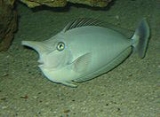
Spotted unicornfish
Encyclopedia
The spotted unicornfish (Naso brevirostris) is a type of Unicornfish
in the family
Acanthuridae
found in the Indian
and Pacific
oceans.. Another species, Naso maculatus
also may be called the spotted unicornfish.
Naso (genus)
The unicorn fishes are 17 species of tropical, herbivorous marine surgeonfishes in the genus Naso. They are so named because of a spike that protrudes from the forehead. Some species have a bulbous protrusion rather than a pronounced spike, and some lack a spike altogether...
in the family
Family (biology)
In biological classification, family is* a taxonomic rank. Other well-known ranks are life, domain, kingdom, phylum, class, order, genus, and species, with family fitting between order and genus. As for the other well-known ranks, there is the option of an immediately lower rank, indicated by the...
Acanthuridae
Acanthuridae
Acanthuridae is the family of surgeonfishes, tangs, and unicornfishes. The family includes about 80 species in six genera, all of which are marine fish living in tropical seas, usually around coral reefs...
found in the Indian
Indian Ocean
The Indian Ocean is the third largest of the world's oceanic divisions, covering approximately 20% of the water on the Earth's surface. It is bounded on the north by the Indian Subcontinent and Arabian Peninsula ; on the west by eastern Africa; on the east by Indochina, the Sunda Islands, and...
and Pacific
Pacific Ocean
The Pacific Ocean is the largest of the Earth's oceanic divisions. It extends from the Arctic in the north to the Southern Ocean in the south, bounded by Asia and Australia in the west, and the Americas in the east.At 165.2 million square kilometres in area, this largest division of the World...
oceans.. Another species, Naso maculatus
Naso maculatus
Naso maculatus is a tropical fish found in coral reefs in the Pacific ocean. It was first named by Randall and Struhsaker in 1981, and is commonly known as the spotted unicornfish,but this name may also refer to Naso brevirostris. It has a maximum length of 60 cm....
also may be called the spotted unicornfish.

